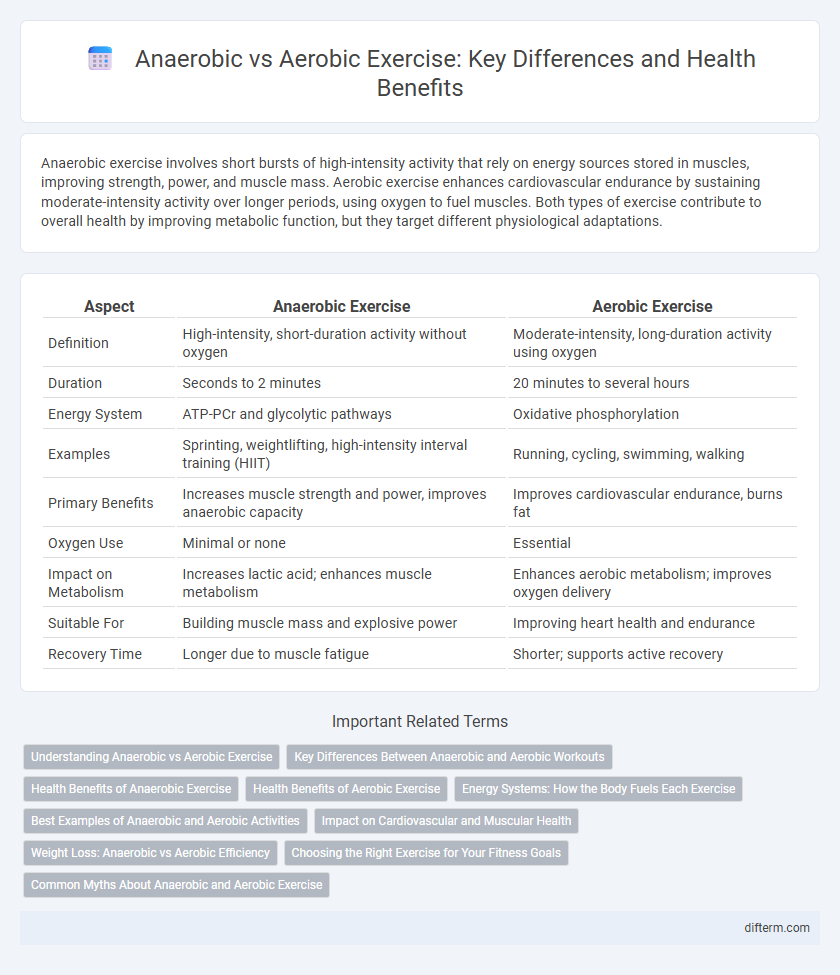Anaerobic exercise involves short bursts of high-intensity activity that rely on energy sources stored in muscles, improving strength, power, and muscle mass. Aerobic exercise enhances cardiovascular endurance by sustaining moderate-intensity activity over longer periods, using oxygen to fuel muscles. Both types of exercise contribute to overall health by improving metabolic function, but they target different physiological adaptations.
Table of Comparison
| Aspect | Anaerobic Exercise | Aerobic Exercise |
|---|---|---|
| Definition | High-intensity, short-duration activity without oxygen | Moderate-intensity, long-duration activity using oxygen |
| Duration | Seconds to 2 minutes | 20 minutes to several hours |
| Energy System | ATP-PCr and glycolytic pathways | Oxidative phosphorylation |
| Examples | Sprinting, weightlifting, high-intensity interval training (HIIT) | Running, cycling, swimming, walking |
| Primary Benefits | Increases muscle strength and power, improves anaerobic capacity | Improves cardiovascular endurance, burns fat |
| Oxygen Use | Minimal or none | Essential |
| Impact on Metabolism | Increases lactic acid; enhances muscle metabolism | Enhances aerobic metabolism; improves oxygen delivery |
| Suitable For | Building muscle mass and explosive power | Improving heart health and endurance |
| Recovery Time | Longer due to muscle fatigue | Shorter; supports active recovery |
Understanding Anaerobic vs Aerobic Exercise
Anaerobic exercise involves high-intensity activities like sprinting or weight lifting that rely on energy sources stored in muscles without using oxygen, promoting muscle strength and power. Aerobic exercise includes moderate-intensity activities such as running, cycling, and swimming, which depend on oxygen intake to sustain prolonged physical effort, enhancing cardiovascular endurance and overall respiratory health. Understanding the distinct metabolic pathways and physiological benefits of anaerobic versus aerobic exercise can optimize fitness training and improve tailored health outcomes.
Key Differences Between Anaerobic and Aerobic Workouts
Anaerobic exercise relies on short bursts of high-intensity effort, primarily utilizing glucose for energy without oxygen, leading to muscle strengthening and increased power. Aerobic exercise involves sustained, moderate-intensity activity that depends on oxygen for energy production, enhancing cardiovascular endurance and fat metabolism. Key differences include energy sources, duration, intensity, and physiological effects, with anaerobic favoring rapid, explosive movements and aerobic promoting prolonged stamina.
Health Benefits of Anaerobic Exercise
Anaerobic exercise enhances muscle strength, power, and mass by engaging in high-intensity activities such as weightlifting, sprinting, and HIIT, which improves bone density and metabolic rate. This form of exercise promotes better insulin sensitivity and supports fat loss while maintaining lean muscle, contributing to long-term metabolic health. Increased production of growth hormones during anaerobic workouts accelerates tissue repair and cardiovascular health, reducing the risk of chronic diseases like diabetes and heart disease.
Health Benefits of Aerobic Exercise
Aerobic exercise significantly enhances cardiovascular health by improving heart and lung function, increasing oxygen circulation, and reducing the risk of chronic diseases such as hypertension, diabetes, and stroke. This form of exercise boosts endurance, supports weight management, and promotes mental well-being through the release of endorphins. Regular aerobic activities like running, cycling, or swimming contribute to lower cholesterol levels and improved immune system efficiency.
Energy Systems: How the Body Fuels Each Exercise
Anaerobic exercise relies primarily on the phosphagen and glycolytic energy systems, using stored ATP and glycogen without oxygen to fuel short bursts of high-intensity activity. Aerobic exercise depends on the oxidative system, utilizing oxygen to convert carbohydrates, fats, and sometimes proteins into sustained energy for prolonged, moderate-intensity workouts. Understanding these distinct energy pathways helps optimize training protocols for endurance or power development.
Best Examples of Anaerobic and Aerobic Activities
High-intensity activities like sprinting, heavy weightlifting, and jumping are prime examples of anaerobic exercise that rely on short bursts of energy without oxygen. Aerobic exercises such as jogging, swimming, and cycling promote cardiovascular endurance by maintaining a steady oxygen flow over extended periods. Both exercise types play crucial roles in overall fitness, improving strength and stamina respectively.
Impact on Cardiovascular and Muscular Health
Anaerobic exercise, characterized by high-intensity, short-duration activities like weightlifting and sprinting, primarily enhances muscular strength and power by promoting muscle hypertrophy and increasing anaerobic capacity. Aerobic exercise, such as running or cycling, improves cardiovascular health by boosting heart and lung efficiency, reducing blood pressure, and increasing oxygen delivery to tissues. Both exercise types contribute to overall cardiovascular and muscular health by improving endurance, metabolic function, and reducing the risk of chronic diseases like hypertension and type 2 diabetes.
Weight Loss: Anaerobic vs Aerobic Efficiency
Anaerobic exercise, characterized by high-intensity activities like sprinting and weightlifting, rapidly burns calories and promotes muscle growth, boosting resting metabolic rate and long-term fat loss. Aerobic exercise, such as jogging or cycling, primarily uses oxygen to sustain prolonged activity, efficiently converting fat into energy and improving cardiovascular endurance. Combining both anaerobic and aerobic workouts maximizes weight loss by enhancing calorie burn during and after exercise through different metabolic pathways.
Choosing the Right Exercise for Your Fitness Goals
Anaerobic exercise, such as weightlifting and sprinting, primarily builds muscle strength and enhances power, making it ideal for goals centered on muscle growth and high-intensity performance. Aerobic exercise, including running, cycling, and swimming, improves cardiovascular endurance and supports fat loss by enhancing oxygen consumption and calorie burn. Selecting the right exercise depends on individual fitness objectives, where anaerobic training suits short bursts of intense activity, while aerobic workouts benefit sustained, moderate-intensity efforts for overall heart health.
Common Myths About Anaerobic and Aerobic Exercise
Anaerobic exercise is often misunderstood as solely for muscle building, while aerobic exercise is mistakenly believed to only improve cardiovascular health; both types enhance metabolic rate and overall fitness. Myth debunking reveals that anaerobic workouts like sprinting or weightlifting also contribute to cardiovascular benefits, just as aerobic activities such as running improve endurance and muscle tone. Understanding the distinct yet complementary roles of anaerobic and aerobic exercise optimizes fitness plans and promotes balanced health outcomes.
Anaerobic exercise vs aerobic exercise Infographic

 difterm.com
difterm.com